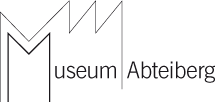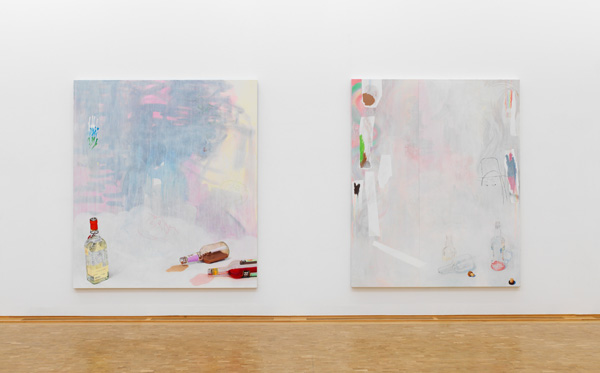The dubious history of painting and questionable outlook for painting´s potential as a currently relevant form of reflection and articulation and have long been a pervasive subject in Baer’s work, from her early paintings to the two, most recent bodies of works on the topic of alcohol made between 2013 and 2015. Forming the heart of this exhibition, the latter show two different approaches to one subject and with it – both in their process and with regard to presentation – a process of duplicity that is characteristic of Baer’s work. The preceeding series Rote Wand (red wall 2011–12) acts as counterpart to the creamy monochrome of the keyhole paintings (rear paintings, 2012), where the claim to a minimalist, abstract image breaks down with the trivial-narrative element of a keyhole. The so-called breast paintings (Untitled, 2008/2009) strike a contrast to the supposedly abstract monochromes (2008–12), which remain caught in a cut-out spider web motif taken from a real spider web.
The new group of alcohol paintings consists on the one hand of a series of (so far) five pastel colored, large-format paintings, with realistically painted, oversized bottles lined up on the lower half: their illusionistic trompe l’oeil effects act as bait, luring the willing eye into the painting. Expanding beyond the bottles is an atmospheric emptiness in which painting itself appears as a kind of hallucination: dynamic brushwork and sketchy drawings of faces – that of the drinker. There are traces of paint that have been applied with fingers, and it is unclear who put them there. Are these gestures – which stand for directness and immediacy in painting – motifs bound within a narrative? The second series in the group is titled on hold. These paintings appear to be the negative image to the other, bright series of paintings – a ghostly counterpart. Some show luminous labels applied with a template – labels belonging to bottles without bodies, swirling in black. Others show spackled cakes of oil paint, bits of paint straight from the tube subjected to gravity, a mirror here and a rainbow motif there. They are all fragments or set-pieces from the artist’s reservoir, appearing here in the manner of objects against a black background – as if this is where they reside when they are not at work in other paintings.
The imagery is marked by a skepticism surrounding the idea of unity and coherent authorship. The impossibilities and possibilities of painting are performed with all their problems: the painting as a stage, staged object, or both. The latest works in the alcohol series reinforce the scenic or theatrical character of Baer’s painting, an aspect that has been virulent in Baer’s work from the very beginning. At the same time, they show a specific combination of expressive gesture, abstraction and Pop Art, a joining of forces on the brink of collapse. A painting’s boundaries and limitations are precisely what activates its potential – but also the line between the painting and non-painting, as when the bottom edge of the painting is literally treated as “below.” This is where the painted objects fall. As we see in Ledge and all the other large-format alcohol paintings in the exhibition, the bottles in the painting are painted just above the lower edge of the painting, almost as if they were resting on the stretcher behind the canvas, as if on a plank. The upper edge of the painting is treated precisely the same way. An object can be placed on top of certain small-format paintings as if on a stage: key, cigarette or liquor bottle – whatever a handbag might be holding. Paintings are clearly treated as objects as soon as the canvas is slashed and the stretcher becomes part of the composition, or when a visible seam holding its parts together runs through the canvas – as in the so-called breast images (Untitled), for example, or the paintings extended failure or in pieces.
Monika Baer’s work could be viewed as an ongoing project where individual thematic groups and their respective working methods give rise to and follow one another, although references to earlier works are ever-present and new elements are always inserting themselves in the arsenal. The operative imagery is heavily loaded: cobwebs and brick walls, playing cards, alcohol and keyholes – a mere listing of these components shows Baer’s ambiguous approach to painting. Its distinguishing characteristics – from painterly gesture, style and intention all the way to attitude – can no longer be in their pure versions, but are unclean, contaminated and exhilarating.
PROGRAM
6 March 2016, 2 pm
ARTIST TALK with Monika Baer
20 April 2016, 8 pm
“Unter Einfluss“ DISCUSSION with Monika Baer and Hans-Jürgen Hafner, director Düsseldorfer Kunstvereins für die Rheinlande und Westfalen
Monika Baer studied at the Kunstakademie Düsseldorf between 1985 and 1992, under Alfonso Hüppi. The artist lives in Berlin and teaches at the Milton Avery School of Fine Art at Bard, New York and in the Berlin program for artists. In 2013/14, two major retrospectives of Baer’s work were shown at the Art Institute of Chicago and the Williams College Museum of Art in Williamstown, Massachusetts, United States.
A new book by Monika Baer will be published as part of the exhibition.
This presentation was funded by the Stiftung Kunstfonds eV and the Hans Fries Foundation. Within the framework of the exhibition, the State of North Rhine-Westphalia supported the purchase of a painting for the Museum Abteiberg collection. The project was conceived in collaboration with the Kestnergesellschaft Hannover, where it will be on view from September 2 to November 6, 2016.


